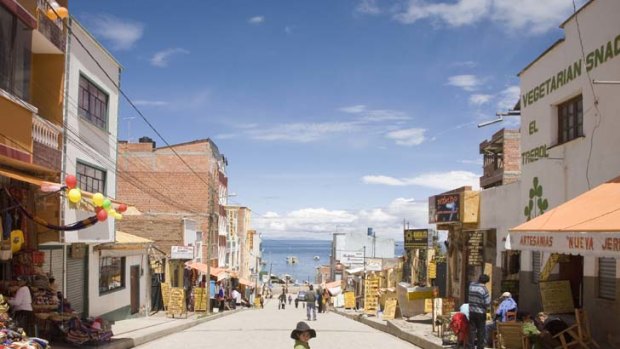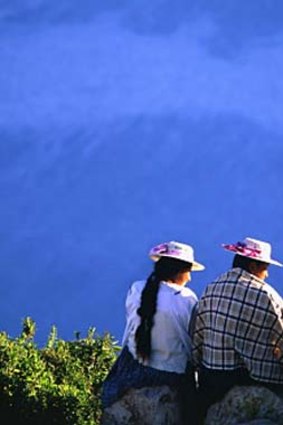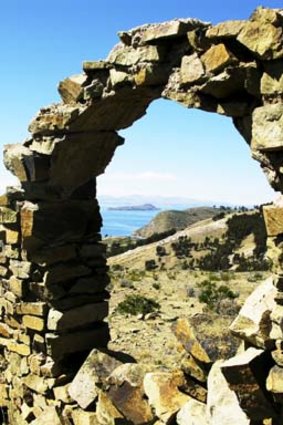
In the Andes ... a boy in a Copacabana street.Credit: Getty Images
Steve McKenna leaves the automotive blessings to the locals to seek Andean inspiration from the landscape around Lake Titicaca.
TRY as I might, I can't help humming Barry Manilow's famous tune when we arrive in Copacabana. We're not talking about the New York nightclub that inspired the American singer (along with Lola the showgirl), nor are we in the famously sexy Brazilian beach suburb. No, this Copacabana is a dusty little Bolivian town that spills down towards the shores of Lake Titicaca, a sprawling, mesmerising body of water swimming in myths and legends.
Nestled high in the Andes, Copacabana isn't the easiest place to get to but those who do make the trip - a three-hour bus ride from Bolivia's capital, La Paz - are handsomely rewarded. Walking through the centre, after checking into my snug lakeside hotel, I pass a hive of handicraft markets and folk wrapped in colourful attire, and stumble across one of the most bizarre rituals I've seen.

Women in traditional dress take in the island.Credit: Getty Images
Benediciones de Movilidades (the blessing of the automobiles) takes place twice a day outside Copacabana's enormous whitewashed, Moorish-style cathedral. For centuries, it has been a site of religious pilgrimages and a place for venerating both the Virgin Mary and Pachamama, a fertility goddess revered by the Andean people. After several hair-raising experiences on Bolivian roads, I'm given an insight into why drivers in this country seem to be so fearless (or, in some cases, downright reckless).
A few dozen souls are waiting patiently alongside their cars and vans, which they've decorated with flowers and confetti. There's an even split between Bolivians wearing modern, Western-style clothes and those in the traditional garb favoured by the town's indigenous Aymara population. The women - in their hand-woven petticoats, shawls, tent-like skirts and bowler hats - are particularly eye-catching.
A young priest arrives, dressed in immaculate white robes and carrying a bucket of holy water. He gathers a family around in a little circle. They bow their heads while prayers are said.

Ruins on the Isla del Sol.Credit: Getty Images
Then the priest begins. He does a thorough job, sprinkling holy water on the car engine, its doors, roof, windows, the boot and even on the seats inside.
The father presses a 10-boliviano ($1.35) note into the priest's hands, bows again, then pours some champagne on his car's engine. As his kids watch, he also takes a swig from the bottle, swills it round his mouth, then spits it on the ground.
Firecrackers start to go off as the priest strolls up to a Land Rover, next to which four empty beer bottles are scattered. After the ritual is completed, the ruddy-faced driver makes the sign of the cross, leaps into the vehicle and puts his foot on the accelerator, speeding off and leaving a trail of dust.
A couple of other tourists are watching. Judging by their horrified expressions, it seems I'm not the only person relieved to be avoiding Bolivia's roads today. My eyes are on the Cerro Calvario, which bears a slight resemblance to Sugarloaf Mountain overlooking Copacabana in Rio de Janeiro - except this hill is 3966 metres high. Thankfully, the summit is just a 40-minute trek from the town centre's heartbeat, Plaza Sucre, which itself lies 3800 metres above sea level.
Despite being in the tropics - and usually having bright, sunny, warmish days - Copacabana's altitude means that, come nightfall, temperatures plummet below zero.
There's a chill in the air as I reach the top of Cerro Calvario, where traders are selling miniature cars and houses. The pious believe that if you buy something and say a prayer either here or at the much-celebrated indigenous Alasitas festival in January, you'll probably get your dream home or car within a year. I keep my hands in my pocket, preferring to savour the spectacular sunset views over Titicaca, straddling the borders of Bolivia and Peru and fringed with snow-capped Andean peaks.
Titicaca is the second-largest lake in South America (after Venezuela's Maracaibo). Its banks were once home to the Tiwanaku civilisation, an agrarian-based society that reached its zenith about 600BC but fell into obscurity about AD1200.
It was eventually replaced by the Inca Empire and the lake is shrouded in Inca folklore. Legend has it that Isla del Sol - an island 10 kilometres offshore - was the birthplace of the Inca sun god and spawned the first Incas, Manco Capac and his sister and wife, Mama Huaco.
The next morning, I hop in a boat and venture there.
Typified by harsh, rocky terrain, the island has no paved roads or motor vehicles and, though at times thigh-straining, is a joy to navigate on foot.
The scenery, as I journey from the island's tip to toe in about four hours, is spell-binding. Minor Inca ruins and stone farmhouses dot the undulating landscape, llamas and donkeys prowl alongside locals who speak more Aymara than Spanish and the water lapping the island's beaches is crystal clear - albeit far too cold for paddling in.
From vantage points you can glimpse Isla de la Luna (Island of the Moon), which is much smaller and, according to another myth, was where the white-bearded god, Viracocha, first summoned the moon.
Both islands were used for rituals, with animals and, occasionally, humans sacrificed to appease the Incas' pantheon of deities. This was stopped in the 16th century with the arrival of Spanish conquistadors, though other Inca traditions have been kept by indigenous people and fused with Catholic values.
It's possible to stay on Isla del Sol overnight; infrastructure has improved dramatically in recent years and there are now several humble, family-run guesthouses to bed down in.
But I opt to return to base camp.
There's less chance of a power cut in Copacabana I reason and besides, it has an excellent choice of homely restaurants where you can escape the biting cold, sit beside roaring fires and dine on hearty portions of fresh trout, hooked from Titicaca that day.
Trip notes
Getting there LAN Chile flies from Sydney to Santiago, priced from $3025. lan.com. Sky Airline links Santiago with La Paz, from $US332 ($308) return. skyairline.cl. All hotels in La Paz organise three-hour road transfers to Copacabana.
Staying there On Copacabana's lake front, Hotel Rosario del Lago has spacious rooms adorned with teak furniture and comfy beds. The walls are decorated with paintings of old locals and streetscapes. Most rooms have wonderful lake views. Doubles are priced from 560 bolivianos ($76). hotelrosario.com/lago.
More information visitbolivia.org.
Sign up for the Traveller Deals newsletter
Get exclusive travel deals delivered straight to your inbox. Sign up now.